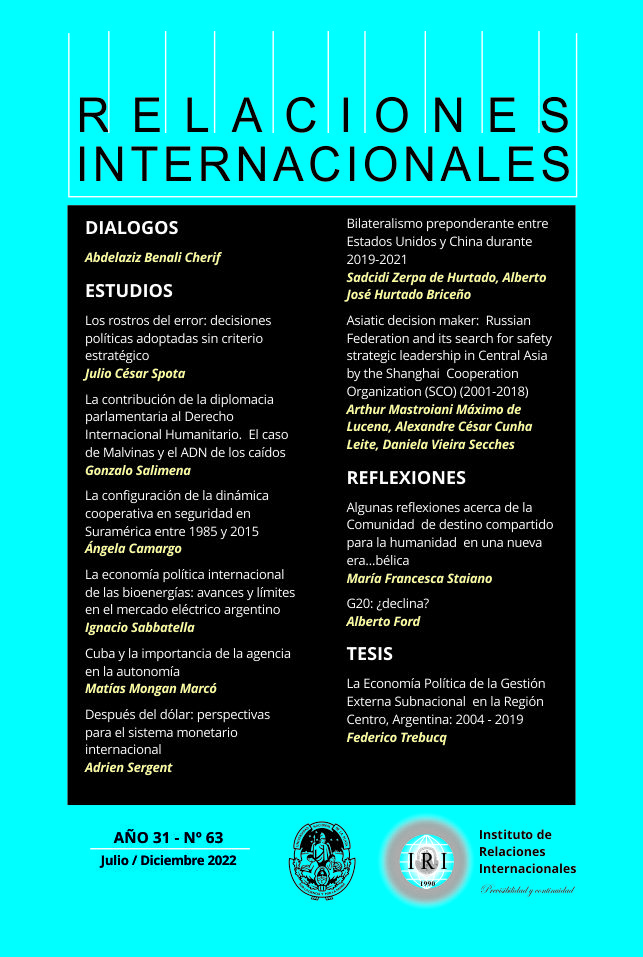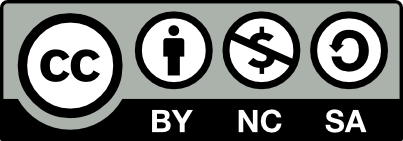Preponderant bilateralism between the United States and China during 2019-2021
DOI:
https://doi.org/10.24215/23142766e154Keywords:
Preponderant bilateralism, China, United States, compensation, cooperation, competenceAbstract
From a comparative analysis perspective, neorealism and liberal institutionalism allow us to analyse variables related to power, interest, the role of institutions and international rules. This paper aims to analyse the preponderant bilateralism between the United States and China during the period 2019-2021. For such purpose, we will use the comparative and case study methods, as they contribute to the understanding of the preponderant US-China bilateralism. This allows thus us to infer that, in the areas of balance and diffusion of power, economic interdependence, and technological and digital interdependence, the prevailing US-China bilateralism moves between hybrid trade-offs and competitive cooperation.
Downloads
References
Actis, E. y Creus, N. (Eds., 2020). Estados Unidos – China y la disputa por el poder global. Capital Intelectual.
Blanco, J. (2014). “Pasos básicos en la modelación ecológica”. Revista Forestal Baracoa, 33 (Número Especial), 471-484.
Burns, N. (2020). Prefacio. En: Nye Jr. y Rice, C. (Comps.), The Struggle for power U.S.-China relations in the 21st century. The Aspen Institute.
Diamond, L. y Schell, O. (2018). Chinese influence & American interests. Promoting constructive vigilance. Stanford University, Hoover Institution Press.
Doshi, R. (2021). The long game. China´s grand strategy to displace American Orden. Oxford University Press.
Graham, A. (2020). The U.S.-China Strategic Competition: Clues from History. En Nye Jr. y Rice, C. (Comp.), The Struggle for power U.S.-China relations in the 21st century. The Aspen Institute.
Gil, T. (2021, 1 de febrero). Estados Unidos vs China: ¿puede la relación entre Pekín y Washington recuperarse tras cuatro años de Donald Trump? https://www.bbc.com/mundo/noticias-internacional-55805132
Hurtado, A.J. y Zerpa de Hurtado, S. (2020). “China-Mercosur: impacto de los acuerdos swaps”. Cuadernos del CENDES, 37(104), 83-103. https://www.researchgate.net/publication/349844813_China-Mercosur_impacto_de_los_acuerdos_swaps
Liang, X y Xu, Y. (2020). Independent or interdependent innovation: The case of Huawei. En: Zhang, W; Alon, I y Lattermann, Ch. (Eds.), Huawei goes global. Volume I: Made in China for the world. Switzerland, Palgrave Studies of Internationalization in Emerging Markets. Macmillan. https://doi.org/10.1007/978-3-030-47564-2
Manuel, A. Singh, P y Paine, T. (2020). Compete, contest, and collaborate: How to win the technology race with China. En Nye Jr. y Rice, C. (Comps.), The Struggle for power U.S.-China relations in the 21st century. The Aspen Institute.
Nye, Jr. J.S. (2020). The Rise of China. En Nye Jr. y Rice, C. (Comp.), The Struggle for power U.S.-China relations in the 21st century. The Aspen Institute.
Sartori, G. (1994). Compare Why and How: Comparing, Miscomparing and the Comparative Method. En: Dogan, Mattei and Ali Kazancigil (eds.), Comparing Nations: Concepts, Strategies and Substance, Oxford, UK and Cambridge, US: Blackwell.
Shambaugh, D. (2020). Toward a “Smart Competition” strategy for U.S. China policy. En Nye Jr. y Rice, C. (Comps.), The Struggle for power U.S.-China relations in the 21st century. The Aspen Institute.
Schell, O. Shirk, S. y Panda, A. (2019, 31 de julio). Reassessing U.S.-China Relations. Competition, confrontation, or collision course? A new report peers into the future of the world's most consequential bilateral relationship. https://www.carnegie.org/our-work/article/competition-confrontation-or-collision-course-reassessing-us-china-relations/
Piovani, J.I. y Krawczyk, N. (2017). Los Estudios Comparativos: algunas notas históricas, epistemológicas y metodológicas, Educação & Realidade, 42 (3), 821-840, Julio- Septiembre. http://dx.doi.org/10.1590/2175-623667609
Vogelmann, J. (2021). Ascending China and the Hegemonic United States. Economically based cooperation or strategic power politics? Springer VS. https://doi.org/10.1007/978-3-658-31660-0
Xuetong, Y. (2020). Bipolar Rivalry in the Early Digital Age, The Chinese Journal of International Politics, pp. 313–341. https://doi.org/10.1093/cjip/poaa007
Downloads
Published
How to Cite
Issue
Section
License
Copyright (c) 2022 Sadcidi Zerpa de Hurtado, Alberto José Hurtado Briceño

This work is licensed under a Creative Commons Attribution-NonCommercial-NoDerivatives 4.0 International License.
Aquellos autores/as que tengan publicaciones con esta revista, aceptan los términos siguientes:
- Los autores/as conservarán sus derechos de autor y garantizarán a la revista el derecho de primera publicación de su obra. A partir de noviembre del 2020 los artículos se publicarán en la revista bajo una licencia Creative Commons Atribución- NoComercial-CompartirIgual 4.0 Internacional (CC BY-NC-SA 4.0). Acorde a estos términos, el material se puede compartir (copiar y redistribuir en cualquier medio o formato) y adaptar (remezclar, transformar y crear a partir del material otra obra), siempre que a) se cite la autoría y la fuente original de su publicación (revista y URL de la obra), b) no se use para fines comerciales y c) se mantengan los mismos términos de la licencia.
Previo a esta fecha los artículos se publicaron en la revista bajo una Licencia de reconocimiento de Creative Commons (BY-SA 2.5). - Los autores/as podrán adoptar otros acuerdos de licencia no exclusiva de distribución de la versión de la obra publicada (p. ej.: depositarla en un archivo telemático institucional o publicarla en un volumen monográfico) siempre que se indique la publicación inicial en esta revista.
- Se permite y recomienda a los autores/as difundir su obra a través de Internet (p. ej.: en archivos telemáticos institucionales o en su página web) antes y durante el proceso de envío, lo cual puede producir intercambios interesantes y aumentar las citas de la obra publicada. (Véase El efecto del acceso abierto).


























